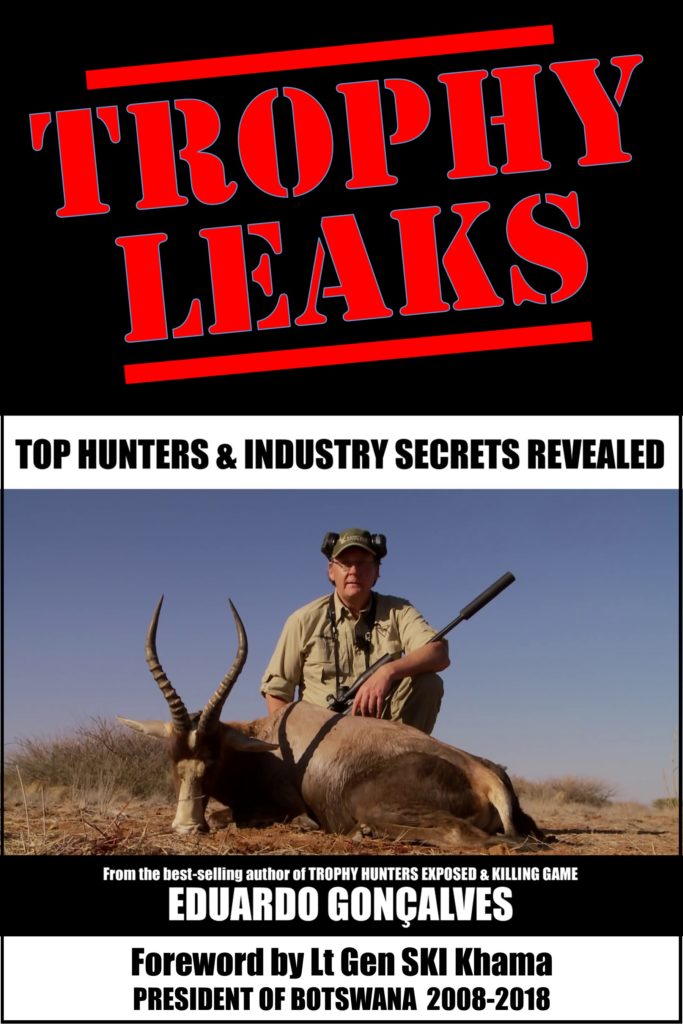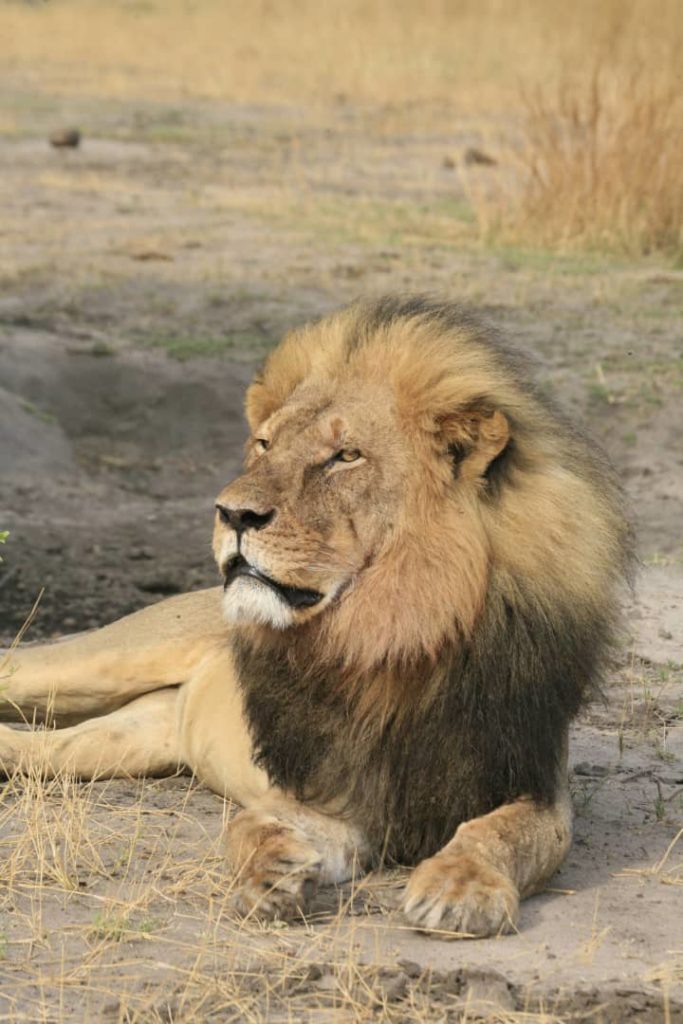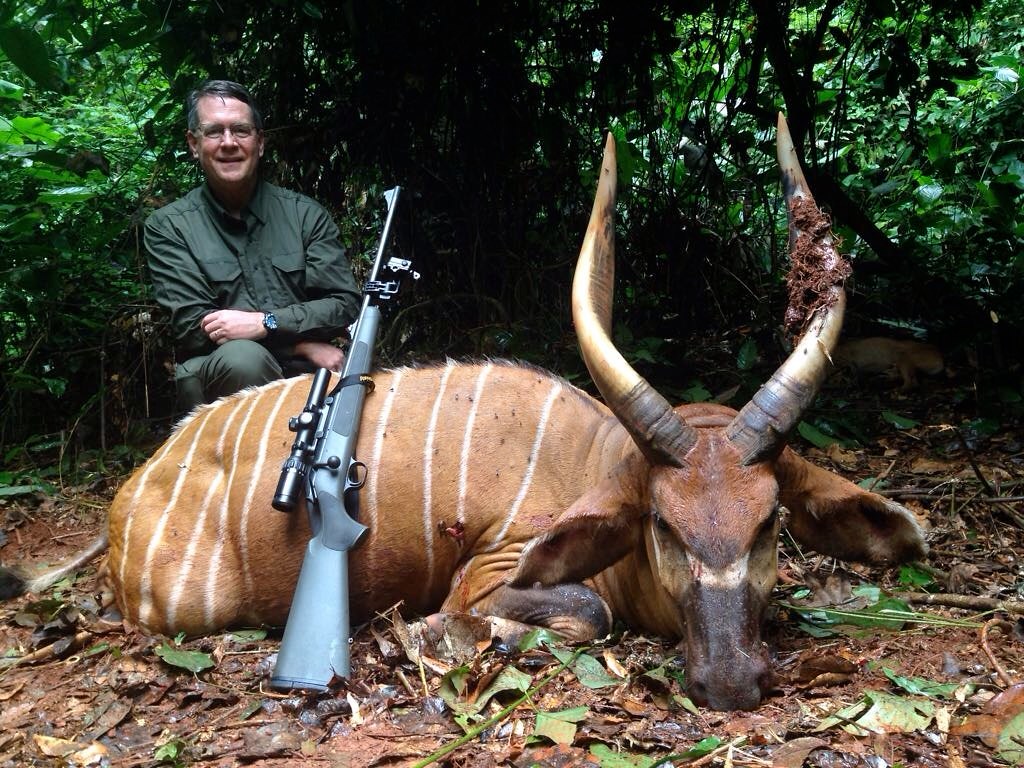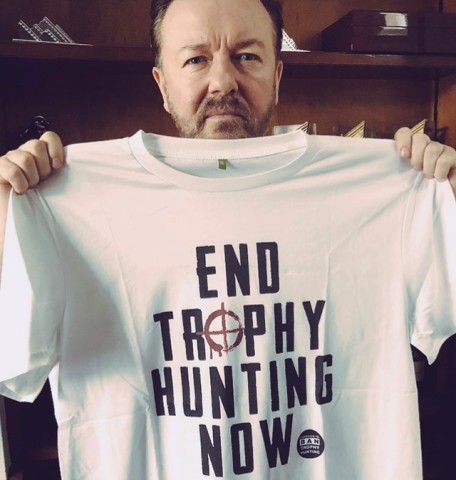Trophy hunting is well-known to be a pastime of the wealthy and powerful, but few people realize just how far that influence reaches. In his newest book, Trophy Leaks: Top Hunters and Industry Secrets Revealed, Eduardo Gonçalves uses investigative reporting to reveal the truth about the trophy hunting industry. Without the usual secrecy of the industry obscuring our view, we are able to see how killing wild animals for fun is made possible, despite disapproval from a majority of the public and supposed protections for vulnerable and endangered species.

As is unfortunately so often the case, the answer lies in following the money. Gonçalves lays out in great detail the various ways trophy hunters and their well-funded organizations have infiltrated governments, regulatory agencies, and even conservation organizations in order to make sure they remain allowed to kill for “sport.” It is shocking to learn about the lengths the industry has gone to and the influence they wield, and this is critical information for anyone fighting to end trophy hunting.
In an interview with Gonçalves, we discussed his book Trophy Leaks, how trophy hunters exploit loopholes in order to kill endangered species, the role Safari Club International plays in keeping the industry alive, where he still finds hope, and much more.
Dylan Forest: After previously working on a variety of issues, you’ve now written three books on trophy hunting and founded an organization (Campaign to Ban Trophy Hunting) dedicated to ending it. What is it about trophy hunting that caused you to focus so much on it?
Eduardo Gonçalves: The scale of trophy hunting, and the power of the industry, is astonishing. Trophy hunting is often portrayed as the occasional actions of a few sick individuals. The truth is that it is violent, senseless slaughter on an industrial scale. An animal is killed by a trophy hunter every 3 minutes. Trophy hunting groups have been given legal loopholes, which allow them to shoot the most endangered animals on earth, just for fun. The industry has poured millions into lobbying, they have funded the campaigns of top politicians, they have pushed their way into international conservation bodies. Their influence is pernicious. Trophy hunting has pushed so many species to the brink of extinction and helped some to disappear altogether. Thanks to the power and influence of these groups it could push many more off the cliff altogether.
Nobody has shone the spotlight on the industry, its power or the slaughter that it is responsible for before. This is what I am seeking to do. People need to be aware of what is going on, how the survival of entire species is at risk thanks to the greed and influence of hunting groups and the weapons and ammunition manufacturers who fund them.
CITES (the Convention on International Trade in Endangered Species) is a global authority on the wildlife trade, but they’ve allowed an exemption for trophy hunters, who are somehow even allowed to kill endangered species, the animals most in need of protection. How is this exemption justified by CITES, and what barriers do you see to changing this so trophy hunters are subject to the same CITES regulations as everyone else?
CITES lays down strict rules and prohibitions around trade in endangered species. Those most at risk of extinction, listed in Appendix I of the convention, cannot be traded at all unless there are what it calls “exceptional circumstances.” Appendix I includes species such as leopards, cheetahs, black rhinos, and some populations of lions and elephants.

Yet leopards are one of the most “popular” animals among trophy hunters. There are only 3,000 black rhinos left on earth, and fewer than 7,000 cheetahs. They’re both in Appendix I, but you can still shoot them if you’re a trophy hunter. Elephants are the most popular trophy animal for British hunters. The world was outraged at the killing of Cecil the lion in 2015, but thousands more lions have been shot since then. Polar bears are for many the symbol of today’s environmental crisis, yet you can still fly to Canada to shoot one and stick its head above your fireplace.
Literally tens of thousands of CITES-listed animals are shot by trophy hunters every year, just for fun. And herein lies the origins of the loophole. Because the trophy hunter kills an animal for thrills rather than to make money, the trophy is effectively a “personal or household effect” – a fashion accessory or item of furniture for personal use. So while an African villager, for instance, can’t kill a wild animal for food or, out of desperation, to make some money, a rich white American or European can jet in and kill the very same animal just for kicks.
Needless to say, this loophole has been joyfully seized upon by wildlife traffickers. Crime syndicates have put Vietnamese peasants and prostitutes on planes to South Africa where they’re told to pose as trophy hunters, shoot a rhino, and bring back the horn, which goes straight into the black market for so-called “traditional Chinese medicine.” The same has happened with various species of bears who have been shot legally as hunting trophies, where the supposed trophies are in fact gallbladders and penises for the same “medicines.” Thousands of crocodiles are bred and shot as hunting trophies for their skins, which make their way into the leather industry. If CITES were a ship, the holes in its sides would have sunk the vessel long ago.
CITES allows trophy hunting groups to be “official observers.” Conservationists at the 2019 CITES conference, which takes place every 3 years, were astonished to see industry representatives being invited by CITES officials to give input in key discussions. The conference agreed to allow trophy hunters to shoot twice as many black rhinos each year. Meanwhile, South Africa has been given special permission by CITES to commercially trade the bones of lions bred in captivity for trophy hunting and traditional Chinese medicines. This is against both the spirit and the letter of the CITES agreement.
Trophy hunters like to call killing animals a form of conservation. Is there any evidence of trophy hunting having a positive effect on animal populations? Is there evidence of trophy hunting negatively affecting wild animal populations?
The idea that killing animals is conservation is utter insanity. A US Congressional review of all the available scientific studies dismissed the industry’s bizarre claims. International Union for Conservation of Nature (IUCN) reports have variously concluded that “big game hunting, in terms of conservation, does not work” and that “trophy hunting is not consistent with sustainable use” of wildlife. When Science magazine published a letter supported by some scientists (but mainly by hunting group lobbyists and supporters) saying trophy hunting was consistent with conservation, the magazine was swamped by letters from groups of scientists around the world angrily criticizing the claims. The magazine was subsequently forced to reveal that the scientists involved in the original letter had received funding from the hunting industry.
Trophy hunting, beginning in the days of colonial empires, has played a key role in catastrophic population collapses of some of the world’s most iconic species. There were 1.2 million lions at the beginning of the 19th century. Now there are just 20,000 (some argue the true figure is closer to 10,000). There were 20 million African elephants; now only 415,000 remain. Some species such as the quagga and scimitar-horned oryx have been almost certainly exterminated by trophy hunters – as recently as the late 20th century in the latter’s case.

One of the most important recent findings is how trophy hunting is threatening the survival prospects of entire species because of the impact it is having on their gene pools. Trophy hunters generally aim for the biggest – and hence the genetically “fittest” – individuals because they are the most impressive ones to show off and are also more likely to get your name into industry record books. We are now seeing dramatic declines in the genetic diversity of lions, elephant tusks are getting shorter, and more and more adult elephants have no tusks at all. Similar evidence has been seen in buffalos, deer and other animals sought after by trophy hunters. What this means is that these species will be less likely to adapt quickly enough in the face of environmental change. As we know, climate change is accelerating, so many animals simply will not survive global heating because they no longer have the best-quality genes in their bloodlines, as these have been removed by trophy hunters.
We are seeing practical consequences of this right now. Droughts are becoming fiercer, more frequent and more prolonged. Elephants need long tusks to find water under dry riverbeds during drought periods. Large numbers of animals are dying from the consequences of drought in Africa each year.
Much of your newest book, Trophy Leaks, is dedicated to the organization Safari Club International (SCI), which spent over 140 million dollars on pro-trophy hunting lobbying between 2000 and 2009. SCI is organized, very well-funded, and unafraid to use money to heavily influence politics, and based on your account it seems like a core piece of how trophy hunting persists. Do you see anything that can be done to reduce its power and influence?
While hunting groups and their lobbyists are extraordinarily wealthy and powerful, they shy away from publicity. They prefer instead to operate in the shadows, largely because they know the vast majority of people are utterly opposed to everything they stand for and would be horrified to learn the truth.
Safari Club International’s election campaign fund is bigger than that of some of America’s biggest corporations, yet the group is far from being a recognizable brand or household name. It hires corporate lobbying firms to represent it, and sub-contracts out “dirty operations” such as its recently-exposed Let Africa Live campaign, which tried to persuade politicians that Africans support trophy hunting. The operation was eventually shut down by Facebook and Twitter after a major investigation.
SCI helps create umbrella bodies such as the Congressional Sportsmen’s Foundation (around half of all members of Congress are members of it) and sets up “conservation” front groups with wildlife-friendly names such as Conservation Force. These groups then lobby and even sue governments to further “hunters’ rights” and help hunters get trophies of endangered animals back home.

SCI and other groups are now deep inside international bodies such as CITES and even the global conservation group IUCN. Safari Club International, its partner group Dallas Safari Club and its favorite conservation front organization Conservation Force have all now acquired membership in IUCN. The head of Conservation Force is a former President of Safari Club International and is one of the world’s top lion (and elephant) trophy hunters. He has no scientific expertise whatsoever, yet sits on the IUCN’s Lions Expert Committee. Many conservation groups and African governments have wanted to move lions into the highest category of endangerment. A comprehensive IUCN assessment called for this to happen, and the US government has warned that lions could be gone from the wild by 2050. The response of Safari Club International and Conservation Force was to run a massive campaign called Fighting for Lions, which was in fact a fight for the rights of hunters to shoot lions and to stop lions from being officially classed as endangered. They won.
Lions are one of the world’s most endangered animals, they are one of the most heavily persecuted by trophy hunters, and they are a species about which there is so much evidence of the devastating impacts of trophy hunting. Yet thanks to Safari Club International, they are not classed as endangered, and there remain few restrictions on shooting lions for fun.
For many people, this will be the first they have heard about this. We need to shine the spotlight on groups like Safari Club International – where their money comes from, where it goes, which international bodies they have infiltrated and are influencing. My books aim to do precisely this, so that the public can make up their own minds, and politicians have the evidence with which to take action.
One of the more horrifying things to me in Trophy Leaks were the quotes from hunters describing the visceral enjoyment and thrill they get from killing animals. It is so hard for me to imagine how otherwise normal and functioning people could proudly stoke this kind of bloodlust. How do you make sense of this?
It is indeed one of the most worrying aspects of trophy hunting. It is certainly one of the things that has left many psychologists and criminologists very concerned. I talked about some of the studies conducted by psychologists on trophy hunters in my first book on the subject, Trophy Hunters Exposed: Inside the Big Game Industry. I reviewed some of the scientific studies looking at the links between trophy hunting, domestic violence, child abuse and even serial killing. Indeed there are a number of trophy hunters who have simultaneously been serial killers. The linkages between these different behaviors are quite clear. They each represent a desire for dominion, a negation of the victim as a sentient or sapient being, basking in the thrill of the kill, and the keeping of a memento as evidence of victorious conquest and to signal superiority to one’s peers.
Many trophy hunters speak openly about their habit as an addiction. Paul Roberts, a gunmaker and one of Britain’s top trophy hunters, equates trophy hunting with “mainlining on heroin” and talks about how hard it is to beat the addiction. The addiction is quite deliberately fed and fueled by industry awards programs. Safari Club International, for instance, has dozens of prizes that it gives out every year to hunters who shoot lots of animals. They have different levels of prizes, rather like different levels on an arcade or computer game. You have to kill a certain number of animals to complete level one, then even more animals to complete level two, and so on. Its Hunting Achievement Award, which has 5 levels going from copper to diamond, is a good example. To win this award at diamond level the hunter has to shoot animals from at least 125 different species around the world. For its Animals of Africa Inner Circle Award you have to shoot 80 or more different African species.

In the past few years, Safari Club International has handed out a staggering 20,000 such prizes to hunters. Not only does this have a devastating impact on the world’s wildlife, fueling and encouraging this mass slaughter of living creatures potentially poses a serious threat to the safety of ordinary people too.
The number of connections between the trophy hunting industry and high-ranking officials in the Trump administration is alarming, and led to a number of “wins” for trophy hunters in the last four years. Do you anticipate this changing under the Biden administration? Does Biden have a mentionable track record on hunting issues, and are you concerned about any connections between his cabinet picks so far and the trophy hunting industry?
It is early days, of course, we shall have to wait and see. However, perhaps one encouraging sign is that Safari Club International has publicly attacked Joe Biden! They issued a furious press release saying that he supports a ban on the import of hunting trophies into the US.
According to SCI, Biden went on record during a virtual town hall meeting in Illinois in March 2020, while campaigning for the Democratic presidential nomination, saying that he was opposed to imports of animals hunted outside the US. Safari Club International CEO W. Laird Hamberlin attacked Biden directly in a statement, adding: “SCI is watching and ready as ever to fight for our people’s right to hunt.”
A month later, in April 2020, Humane Society International published a report on Joe Biden’s record on animal protection issues. In its summary, the report stated that “Biden has a long and positive legacy on our concerns.” On hunting issues specifically, it noted that Biden was lead author in the 107th Congress of a bill seeking to ban canned hunting (the Captive Exotic Animal Protection Act, Senate bill 1655), was a co-sponsor of a Senate Resolution calling on Canada to end commercial seal hunting, supported an amendment to stop federal funding of steel-jaw leghold traps and neck snares in National Wildlife Refuges, and co-sponsored a resolution opposing whaling.
It can be hard to imagine ending this practice after reading your detailed account of the amount of money and influence the trophy hunting industry has. What brings you hope that change is possible, and what do you see as the clearest path to ending trophy hunting?
I’m hopeful not least because the vast majority of people agree trophy hunting is a shameful relic of the past. There are exciting new developments. Colombia has banned all so-called “sport” hunting. This ban follows a court decision which upheld the argument that killing animals for pleasure conflicted with provisions in the country’s constitution guaranteeing the welfare of animals and wildlife conservation. In Africa, the Akashingas, Zimbabwe’s formidable all-female antipoaching unit, is taking over land previously used for trophy hunting. Their project has generated more revenue for people and conservation in thirty-four days than trophy hunting did in a year.

Here in the United Kingdom, this issue was nowhere on the political agenda 2 years ago. Just 1 year later, a pledge to ban trophy imports was in the election manifesto of every major party in Britain. A ban has been mentioned in the Queen’s Speech, Boris Johnson has promised it in the House of Commons, there has been a public consultation on proposals, and draft legislation is being drawn up right now as I write this. This shows that change is indeed possible.
A UK ban will have particularly symbolic significance. It was the British who invented modern trophy hunting and exported it to its African and Indian colonies. It will send a loud message to the international community if Britain closes this chapter in its history. I believe a UK ban will fire the starting gun for the next phase of the work we must do – namely, end all trophy hunting everywhere. That is why we must do all we can to support its safe passage through Parliament, defeat any moves by opponents to water it down, and then get on with consigning all trophy hunting to the dustbin of history for good.
Featured image: a trophy hunter poses with a dead gemsbok. Image credit mrshife, CC BY-SA 2.0.






1 Comment
It is heartbreaking and sickening to learn what is happening to our wildlife. These people who call themselves hunters are nothing more than murderers. The hunts are often “canned” where the animal is trapped and doesn’t have a chance. Now children are are taken on these “hunts” and encouraged to participate.
All countries should immediately put a ban on importing and exporting of these “trophies”. Our wildlife belong in the wild where they were born and raised. They do not belong hanging on somebody’s wall or made into clothing . The people who participate or are involved in any way must have no heart and no soul. Can only hope that one day they find out what it feels like to be hunted and gunned down for somebody else’s pleasure, .